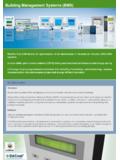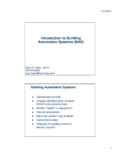Transcription of Guidelines for the Design and Construction of …
1 Guidelines for the Design and Construction of Stormwater management SystemsDeveloped by the New York City Department of Environmental Protection in consultation with the New York City Department of BuildingsJuly 2012 Michael R. Bloomberg, MayorCarter H. Strickland, Jr., CommissionerCover: An extensive green roof system installed atop the NYC Department of Parks and Recreation s (DPR) Five Borough Building on Randall s Island. This modular system is one of six variations installed on the roof and covers 800 square feet, con-sisting of two-foot by two-foot trays with six inches of mineral soil and over 1,500 sedum plugs. DPR has installed 25 green roof systems covering over 29,000 square feet on the Five Borough Building rooftop to feature different types and depths of growing medium and plant Friends;The NYC Green Infrastructure Plan, released in September 2010, proposed an innovative ap-proach for cost-effective and sustainable stormwater management .
2 A major part of this plan is our commitment to manage the equivalent of an inch of rainfall on ten percent of the impervious areas in combined sewer watersheds by 2030. To that end, DEP is prepared to spend $ bil-lion to construct green infrastructure projects across the city. Yet public investment alone will not achieve our water quality goals, or our desired recreation and development of the most cost-effective opportunities are represented by new Construction and devel-opment, when stormwater source controls can be easily included in designs and built at a frac-tion of the cost of retrofitting existing buildings. DEP initiated a citywide rulemaking process and worked closely with development, labor, and environmental organizations over two years. In response to suggestions received in that process, DEP worked with the Department of Build-ings to develop an informative guidance document to accompany the rule. The information contained in this document will ease the development community s transition to stricter storm-water release rates when connecting to the City s combined sewer system .
3 These Guidelines will continue to evolve as we learn more from our pilot projects and as stormwater regulations change. We welcome feedback about the structure and content of this document. Together we are proud to say that New York City has taken a critical step toward further improving harbor water quality and making our city greener and greater than ever ,Carter H. Strickland, Jr. CommissioneriTABLE OF CONTENTS 5 Table of Contents1 Introduction .. Purpose and Scope of Document .. Stormwater management in New York City .. City Development and Review Process .. Types of Stormwater management Systems .. Selecting an Appropriate system .. Responsibilities of the Licensed Professional and Property Owner .. Document Organization ..132 Sizing Stormwater management Systems.. Calculating Developed Site Flow and Runoff Coefficients .. Determining the Release Rate, Storage Volume, and Storage Depth .. Subsurface system Sizing Calculations.
4 Sizing Vault Systems .. Sizing Gravel Bed Systems .. Sizing Perforated Pipe Systems .. Sizing Stormwater Chamber Systems .. Rooftop system Sizing Calculations .. Sizing Blue Roof Systems .. Sizing Green Roof Systems .. Storage Volume Reduction Calculations .. Determining Volume Reduction from Infiltration .. Determining Volume Reduction from Recycling .. Sizing Combination Systems .. Calculate the Release Rate .. Determine Available Storage Volume on Roof .. Calculate Effective Runoff Coefficient .. Calculate the Required Volume for the Subsurface system ..34ii5 TABLE OF CONTENTS3 Subsurface Systems .. Types of Subsurface Systems ..36 Storage Vaults and Tanks ..36 Gravel Beds ..37 Perforated Pipes ..37 Stormwater Chambers .. Siting Considerations for Subsurface Systems ..38 Soil, Bedrock, and the Water Table ..39 Buffers and Setbacks ..39 Utility system Configuration .. Subsurface system Design .
5 44 Inlets and Drains ..44 Pretreatment ..45 Outlet Control Observation Well ..48 Materials ..48 Surface Loading ..48 Climate Considerations .. Subsurface system Construction ..52 Pre- Construction Meeting ..52 Soil Excavation, Field Testing, and Disposal Excavation ..52 Installation of Subsurface Systems ..54 Construction Inspections and As-Built Certification .. Operations and Maintenance for Subsurface Systems ..60 Post- Construction Monitoring (First Year) ..60 Inspections ..60 Maintenance ..61 Developing an Inspection and Maintenance Plan ..63 Troubleshooting ..64iiiTABLE OF CONTENTS 54 Rooftop Systems .. Types of Rooftop Blue Roofs .. Green Roofs .. Siting Considerations for Rooftop Systems .. Site and Building Characterization .. Complementary Uses .. Considerations for Multiple Roof Levels .. Rooftop system Design .. Roof Assemblies and Materials .. Waterproofing Membrane.
6 Leak Detection Systems .. Roof Drains and Scuppers .. Roof Slope, Ponding Depth, and Drainage Configurations .. Growing Media and Vegetation .. Loadings and Structural Capacity .. Climate Considerations .. Rooftop system Construction .. Pre- Construction Meeting .. Waterproofing system .. Installation of Controlled Flow Drains .. Installation of Green Roof Systems .. Construction Inspections and As-Built Certification .. Operations and Maintenance for Rooftop Systems .. Post- Construction Monitoring .. Inspections .. Maintenance .. Developing an Inspection and Maintenance Plan .. Troubleshooting ..985 Combination Systems .. Combination Rooftop and Subsurface Systems .. Impervious Surface Reductions and Rainwater Recycling ..102iv5 TABLE OF CONTENTSR eferences and ResourcesAcknowledgements Appendix A GlossaryAppendix B Applicable Stormwater Codes and Regulatory RequirementsAppendix C Required Submittals for DEP and DOB CertificationAppendix D City Permitting ProcessesAppendix E Recommended Planting List for Porous Infiltration PracticesAppendix F Recommended Planting List for Green RoofsAppendix G Variables Used in Sizing of Stormwater management SystemsAppendix H Soil Evaluations for Porous Infiltration PracticesAppendix I Permeability Test ProcedureAppendix J AcronymsSection 1 IntroductIonNative beds established on the green roof at DPR s Five Borough Building on Randall s New York City Department of Environ-mental Protection (DEP) is responsible for the city s drainage plan and stormwater management .
7 Through DEP approval of sew-er certifications (approval that the City sew-er can accept the proposed discharge) and subsequent sewer connection permits (au-thorization to connect to a sewer), DEP limits the allowable flow from development lots to provide adequate capacity in the sewer sys-tem based on sewer Design criteria. Recently, DEP has revised its stormwater rules for new development and redevelop-ment in combined sewer areas. The new performance standard is intended to reduce peak discharges to the city s sewer system during rain events by requiring greater on-site storage of stormwater runoff and slow-er release to the sewer system . The imple-mentation of DEP s stormwater performance standard over time is expected to provide additional capacity to the existing sewer sys-tem, thereby improving its performance. The performance standard is a key element of the New York City Green Infrastructure Plan (the NYC Green Infrastructure Plan ) to promote green infrastructure and improve water qual-ity in the city s surrounding waterbodies.
8 21 Purpose and Scope of DocumentDEP s stormwater performance standard is in-tended to reduce adverse impacts on the city s combined sewer system from runoff during rain-storms that are more severe than sewers and related facilities are designed to handle. When excessive stormwater enters the combined sewer system from impervious surfaces, it can cause combined sewer overflows (CSOs), flood-ing, and sewer backups. By slowing the flow of stormwater to the sewers, the stormwater per-formance standard allows the city to manage stormwater runoff from new development and redevelopment more effectively and maximize, to the greatest extent possible, the capacity of the city s combined sewer systems. These Guidelines were developed by DEP, in consultation with the New York City Depart-ment of Buildings (DOB), to provide guidance to New York City s development community and licensed professionals for the planning, Design and Construction of onsite source controls that comply with DEP s stormwater performance standard.
9 The stormwater performance standard was promulgated on [DATE] as an amendment to Chapter 31 of Title 15 of the Rules of the City of New York, Rule Governing House/Site Con-nections to the Sewer system Standards for Release Rates ( Chapter 31 ). These Guidelines reflect the requirements of these rules and the New York City Construction Codes ( Construc-tion Codes ), as administered by DOB. While these Guidelines are provided to assist the development community, licensed profes-sionals always maintain the responsibility to submit acceptable designs in accordance with all applicable laws, rules, and regulations and property owners are responsible for maintain-ing onsite constructed systems. Stormwater Performance StandardSection 3 of Chapter 31 was revised to include the Stormwater Performance Standard for Con-nections to Combined Sewer system ( storm-water performance standard ).
10 As a result, the following requirement applies to proposed de-velopments that require a New Building permit from DOB ( new development ) in combined sewer areas of the city: The Stormwater Release Rate must be no more than the greater of cfs or 10% of the Allowable Flow or, if the Allowable Flow is less than cfs, no more than the Allow-able proposed redevelopments in combined sewer areas of the city, the following require-ment applies to alterations, as defined in the Construction Codes and related requirements, for any horizontal building enlargement or any proposed increase in impervious surfaces:The Stormwater Release Rate for the altered area must be no more than the stormwater release rate for the entire site, determined in accordance with the requirement above, mul-tiplied by the ratio of the altered area to the total site area.
















